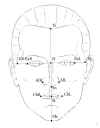The comparison of facial estethics between orthodontically treated patients and their parents
- PMID: 24222754
- PMCID: PMC3814064
- DOI: 10.1155/2013/903507
The comparison of facial estethics between orthodontically treated patients and their parents
Abstract
Orthodontists emphasize the importance of facial esthetics while planning a treatment, and orthodontist state that orthodontics have more than expected effects on dentofacial esthetics. The facial esthetics of treated patients and their parents was analyzed and compared to define facial growth and to use in forensic sciences. Our study was applied to 45 orthodontic patients who were treated in our clinic and their untreated parents. The patients were divided into Classes I, II, and III groups according to their malocclusions. Pre- and posttreatment changes, pretreatment facial esthetics of the paitents and its accordance with their parents, and the calculation of heritability tests were performed. After the statistics, for pre- and posttreatment changes, all the groups except Class I revealed significant changes. There were significant correlations of patients for the heritability values and pretreatment esthetic in accordance with parents, but there were more correlations of fathers when compared to mothers. The facial esthetics in adolescences is related with so many factors, not only related with one factor. The facial esthetics in fact includes the aim of evaluation of facial properties partly or totally. Because orthodontic treatments affect facial esthetics, performing similar studies for the treatment outcomes, capabilities, and borders is important.
Figures


Similar articles
-
Panel perception of facial attractiveness.Br J Orthod. 1990 Nov;17(4):299-304. doi: 10.1179/bjo.17.4.299. Br J Orthod. 1990. PMID: 2285698
-
Facial soft tissue changes after orthodontic treatment.Niger J Clin Pract. 2014 May-Jun;17(3):282-6. doi: 10.4103/1119-3077.130226. Niger J Clin Pract. 2014. PMID: 24714003
-
Assessment of dental and facial aesthetics in adolescents.Eur J Orthod. 1998 Aug;20(4):399-405. doi: 10.1093/ejo/20.4.399. Eur J Orthod. 1998. PMID: 9753821
-
Facial keys to orthodontic diagnosis and treatment planning. Part I.Am J Orthod Dentofacial Orthop. 1993 Apr;103(4):299-312. doi: 10.1016/0889-5406(93)70010-L. Am J Orthod Dentofacial Orthop. 1993. PMID: 8480695 Review.
-
Facial aesthetics in orthodontics.Aust Orthod J. 2001 Mar;17(1):17-26. Aust Orthod J. 2001. PMID: 11506166 Review.
Cited by
-
Differences in Angular Photogrammetric Soft-Tissue Facial Characteristics among Parents and Their Offspring.Medicina (Kaunas). 2019 May 23;55(5):197. doi: 10.3390/medicina55050197. Medicina (Kaunas). 2019. PMID: 31126130 Free PMC article.
References
-
- Harris JE, Kowalski CJ. All in the family: use of familial information in orthodontic diagnosis, case assessment, and treatment planning. American Journal of Orthodontics. 1976;69(5):493–510. - PubMed
-
- Harris JE, Kowalski CJ, Walker SJ. Intrafamilial dentofacial associations for Class II, Division 1 probands. American Journal of Orthodontics. 1975;67(5):563–570. - PubMed
-
- Markovic MD. At the crossroads of oral facial genetics. European Journal of Orthodontics. 1992;14(6):469–481. - PubMed
-
- Corruccini RS, Potter RH. Genetic analysis of occlusal variation in twins. American Journal of Orthodontics. 1980;78(2):140–154. - PubMed
-
- Lundstrom A, McWilliam J. The influence of heredity and environment on six variables describing incisor orientation. European Journal of Orthodontics. 1986;8(4):259–264. - PubMed
Publication types
MeSH terms
LinkOut - more resources
Full Text Sources
Other Literature Sources

